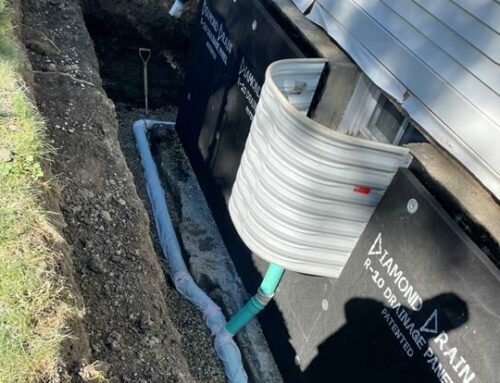Discover the secret to a dry and stable home with proper foundation drainage.
Foundation drainage, also known as footing drains, is a crucial system that protects your home from water damage. By preventing water accumulation, foundation shifting, and basement flooding, this system ensures the longevity and safety of your investment.
Learn how footing drains work, the common materials used, and the signs of a faulty system.
Explore alternative measures to prevent water damage, and take proactive steps to safeguard your property.
Key Takeaways
- Footing drains, also known as foundation drains, are essential for preventing water accumulation and damage to a building’s structure, including foundation shifting, cracking, and basement flooding.
- Proper installation and maintenance of footing drains help ensure a solid foundation, increase the lifespan of a building, and protect the investment in the property.
- Perforated pipes, such as PVC, ABS, and corrugated HDPE, are commonly used for footing drains due to their durability and ease of installation.
- Signs of a faulty footing drain system include water seepage or dampness in the basement, cracks in the foundation walls or floors, mold or mildew growth, and frequent or continuous operation of the sump pump.
Definition and Importance of Footing Drains
Footing drains, also known as foundation drains, are an essential component for maintaining a dry and stable home. These drains are responsible for preventing water accumulation and potential damage to the structure, such as foundation shifting, cracking, and basement flooding.
Professional installation of footing drains offers several advantages, including expertise in proper placement, grading, and use of quality materials. It ensures that the system functions optimally to protect the foundation and prevent water damage.
To maintain the effectiveness of footing drains, regular maintenance is crucial. Here are some maintenance tips:
1) Regularly inspect the drains for any clogs or blockages caused by debris.
2) Ensure proper slope and grading away from the foundation to encourage water flow.
3) Consider professional cleaning or flushing of the drains to remove any accumulated sediment.
4) Address any signs of water seepage or dampness promptly to prevent further damage.
How Footing Drains Work and Common Materials Used
To effectively manage water around a building’s foundation and prevent damage, a properly functioning drainage system utilizes perforated pipes placed strategically around the structure. Here is how footing drains work and the common materials used:
Installation process: – Perforated pipes are installed in a gravel bed around the foundation. – The pipes filter out dirt and debris, while the gravel and soil create a slope away from the foundation. – This allows water to flow into the pipes and be directed away from the building.
Benefits of gravel bed: – The gravel bed acts as a filter, preventing clogging and prolonging the lifespan of the drainage system. – It also helps to distribute water evenly, reducing the chances of localized flooding. – The gravel bed facilitates proper drainage and prevents water from accumulating near the foundation, which can cause damage.
Common materials used: – PVC, ABS, and corrugated HDPE pipes are commonly used for footing drains due to their durability, corrosion resistance, and ease of installation. – Gravel and other drainage materials are also commonly used in the installation of footing drains.
Signs of a Faulty Footing Drain System
A malfunctioning footing drain system can be identified through various indicators of water damage and compromised structural integrity. Common causes of a faulty footing drain system include clogs or blockages in the pipes, improper installation, and deterioration over time.
Signs of a faulty system include water seepage or dampness in the basement or crawl space, cracks in the foundation walls or floors, mold or mildew growth, and unpleasant odors.
If you suspect a problem with your footing drain system, it is important to take immediate action to prevent further damage. Steps to repair a faulty footing drain system may include locating and clearing any clogs, repairing or replacing damaged pipes, and ensuring proper installation and maintenance.
Seeking the assistance of a professional who specializes in foundation drainage is recommended to ensure a thorough and effective repair.
Alternatives to Footing Drains
Sump pumps can serve as a viable alternative to traditional footing drains for redirecting water away from a building’s foundation. Here are some alternatives to consider:
- Surface drainage systems, such as French drains, can help redirect water away from the foundation. These systems use perforated pipes and gravel to collect and redirect water.
- Exterior waterproofing coatings can provide an additional layer of protection. These coatings create a barrier between the foundation and water, preventing moisture from seeping into the structure.
- Proper grading and landscaping can help prevent water accumulation near the foundation. Ensuring that the ground slopes away from the building and using vegetation to absorb excess water can be effective.
- Gutters and downspouts should be properly installed and maintained to direct water away from the foundation. Regularly cleaning the gutters and ensuring downspouts extend at least six feet away from the building can help prevent water from pooling around the foundation.
Flooding Prevention Measures
Implementing effective measures to prevent flooding is essential for maintaining a dry and stable home. Regular inspection and maintenance of the footing drain system is critical to ensure its proper functioning. This includes checking for any clogs or blockages in the pipes, as well as repairing any leaks or damages.
Additionally, sump pump maintenance is necessary to ensure its reliability during heavy rainfall or flooding situations. Regular testing and cleaning of the sump pump, as well as ensuring the battery backup system is in good working condition, are important steps to take.
Another important measure is the use of exterior waterproofing coatings. These coatings provide an additional layer of protection for the foundation, preventing water from seeping into the basement or crawl space.
Frequently Asked Questions
What Are the Benefits of Using Gravel and Soil in the Installation of Footing Drains?
Gravel and soil mixture is commonly used in the installation of footing drains. It filters out dirt and debris, allowing water to flow freely. This installation method promotes proper drainage and helps prevent clogs, ensuring the system functions effectively.
Can Footing Drains Be Installed in Existing Buildings, or Are They Only Used in New Construction?
Footing drains can be retrofitted in existing buildings to address water accumulation issues. While exterior drainage systems are typically more effective, interior drainage systems can be installed to mitigate water damage and stabilize the foundation.
Are There Any Specific Regulations or Codes That Dictate the Installation or Maintenance of Footing Drains?
Regulations and codes for the installation and maintenance of footing drains may vary depending on the jurisdiction. Regular inspection and maintenance are essential homeowner tasks to ensure the system’s proper functioning and reap the benefits of a dry and stable home.
How Often Should a Footing Drain System Be Inspected and Maintained?
Footing drain maintenance frequency depends on various factors such as climate, soil conditions, and the age of the system. It is recommended to inspect and maintain the footing drain system annually to ensure its proper functioning. Signs of footing drain system issues include water seepage, cracks in the foundation, mold growth, and frequent sump pump operation.
Are There Any Specific Maintenance Tasks That Homeowners Can Do Themselves to Ensure the Proper Functioning of Their Footing Drain System?
To ensure the proper functioning of their footing drain system, homeowners can perform DIY maintenance tasks such as regularly inspecting for clogs or blockages, clearing debris from gutters and downspouts, and checking for signs of water seepage or dampness in the basement. Troubleshooting common issues is crucial in maintaining the system’s efficiency.
Choose Behm for Reliable Foundation and Drainage Care!
Foundation drainage and footing drains are not just essential components of building construction; they are the guardians of your property’s structural integrity. Ignoring the health of these systems can lead to significant damage and costly repairs. Remember, water damage is a slow and silent adversary, but with the right approach and maintenance, its effects can be effectively mitigated.
At Behm Enterprises, we deeply understand the critical role of a solid foundation and an efficient footing drain system. Our 35 years of experience in the industry have equipped us with the knowledge and skills necessary to tackle the challenges posed by water damage. We’ve witnessed first-hand the impact of neglected drainage systems, and it’s our mission to prevent these issues from affecting your home or business.
Educating our customers about the benefits and maintenance of footing drains is a cornerstone of our service. We’re committed to helping you protect your investment and ensure your peace of mind, knowing that your foundation is in safe hands. Whether you’re looking for installation, maintenance, or repair services, our team of skilled professionals is ready to provide the expertise you need.
Don’t wait until it’s too late to address the health of your foundation drainage system. Contact Behm Enterprises today to schedule a consultation. We’re here to help you understand the best ways to protect your home or business from the threats posed by water damage. Let us be your partner in securing the longevity and safety of your property.
Take the first step towards safeguarding your property. Reach out to Behm Enterprises now, and let’s work together to keep your foundation strong and dry.



